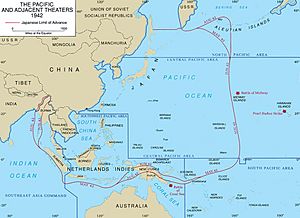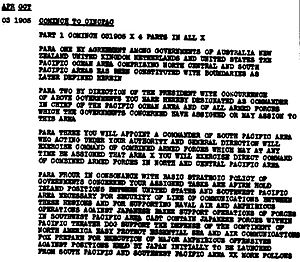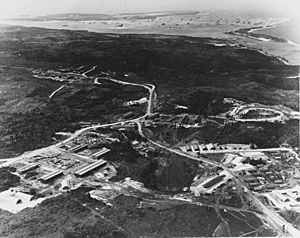Pacific Ocean Areas facts for kids
Quick facts for kids Pacific Ocean Areas |
|
|---|---|

Map of Pacific Theater
|
|
| Country | |
| Allegiance | Allies of World War II |
| Anniversaries | March 30, 1942 |
| Engagements | Pacific War |
| Commanders | |
| Historic commander | Chester Nimitz |
The Pacific Ocean Areas was a very important military command for the Allied forces during World War II. It covered a huge part of the Pacific Ocean. This command was one of the main Allied groups fighting in the Pacific War.
Admiral Chester W. Nimitz from the U.S. Navy led the Pacific Ocean Areas throughout the war. Most of the soldiers, sailors, and marines in this area were from the United States. However, troops from New Zealand, the United Kingdom, Australia, Canada, Mexico, Fiji, and other countries also helped.
How the Pacific Ocean Areas Were Set Up
In March 1942, the British and U.S. military leaders decided that the Pacific area would be mainly America's responsibility. On March 30, the U.S. Joint Chiefs of Staff (JCS) divided the Pacific into three main parts. These were the Pacific Ocean Areas (POA), the South West Pacific Area (SWPA), and the Southeast Pacific Area. The Southeast Pacific Area was never fully used.
Admiral Nimitz was put in charge of the Pacific Ocean Areas. He controlled all the air, land, and sea forces there. This huge area included most of the Pacific Ocean and its islands. However, places like mainland Asia, the Philippines, Australia, and the Netherlands East Indies were not part of the POA. Also, large bomber planes in the area were directly controlled by the JCS.
The JCS further divided the Pacific Ocean Areas into three smaller sections: the North, Central, and South Pacific Areas. Nimitz chose commanders for the North and South Pacific Areas. But he kept direct control over the Central Pacific Area, which included the Army's Hawaiian Department.
General Douglas MacArthur was put in charge of the South West Pacific Area (SWPA). This created two separate main commands in the Pacific: POA and SWPA. Both reported directly to the JCS. They sometimes competed for resources, as both areas were very important.
A good example of this was the Solomon Islands campaign. The main Japanese bases were in MacArthur's SWPA. But the main Allied bases were in Nimitz's POA. However, MacArthur's plan, called Operation Cartwheel, worked very well. He gave Admiral William Halsey (from POA) full control of naval and amphibious forces in the Solomons. This worked because MacArthur and Halsey had a great relationship. When Halsey operated west of a certain line (159° east longitude), he reported to MacArthur. When he was east of that line, he reported to Nimitz.
Forces That Fought in the POA
Many different military units fought in the Pacific Ocean Areas. During the 1942 Aleutian Islands campaign, Rear Admiral Robert A. Theobald led Task Force 8. This force included cruisers, destroyers, submarines, and naval aircraft.
From 1942 to 1943, several U.S. Army and Marine divisions fought in the POA. These included the 23rd, 25th, and 27th Army Infantry Divisions. The 1st and 2nd Marine Divisions also served there. The 1st and 3rd Marine Divisions also fought in the SWPA.
From 1944 to 1945, even more divisions joined the fight. Five Army infantry divisions (7th, 27th, 77th, 81st, 96th) and six Marine divisions (1st, 2nd, 3rd, 4th, 5th, 6th) were active in the POA. The 3rd New Zealand Division also fought in the Solomon Islands campaign during 1943-1944.
U.S. Army Air Forces also played a big role in the POA. The Seventh, Thirteenth, and Twentieth Air Forces operated there. In 1944, a new headquarters for Army Air Forces in the Pacific Ocean Areas (AAFPOA) was set up. Lt. Gen. Millard F. Harmon was chosen to lead it. He had a lot of experience in the Pacific.
The AAFPOA headquarters officially started on August 1, 1944. The Seventh Air Force became more focused on combat. Other forces like the XXI Bomber Command also operated under AAFPOA. Air bases and depots were expanded to support the large number of planes.
Allied air forces also included units from the Royal New Zealand Air Force.
See also
- United States Navy in World War II
- US Naval Advance Bases



